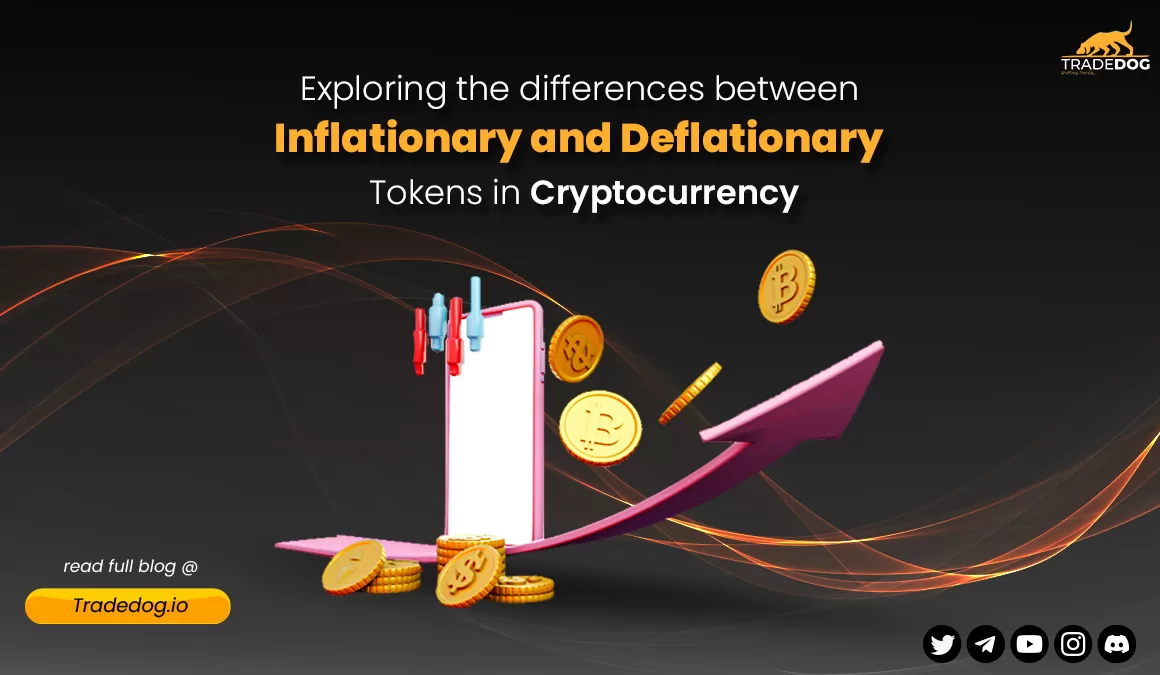Quick Links
Inflation and Deflation are economic concepts which describe an overall change in the price level of goods and services in an economy over a period of time. In traditional economics & finance, the entire world revolves around Inflation & Deflation. These topics are probably the most basic yet the most important to understand the world of cryptocurrencies & tokenomics.
Let’s talk economics and find out what Inflation & Deflation mean in a crypto sense. Also, today we’ll dig into how & why bitcoin isn’t DEFLATIONARY (wait, what?).
For a currency, Inflation would mean that the purchasing power of a unit of currency decreases over time due to an increase in the prices of goods & services. Whereas Deflation is the concept where the purchasing power of a unit of currency increases, as the cost of goods and services decreases.
Inflationary cryptocurrencies
An Inflationary cryptocurrency refers to a coin that has an unlimited supply in the market. This essentially means that the total number of coins in the system are continuously increasing as time goes by.
As supply grows, the inherent intrinsic underlying value decreases. Inflationary cryptocurrencies have a declining purchasing power since the Value of Money decreases as more & more supply enters the market. In basic economic terms, each subsequent year an inflationary token buys less than what it could buy in the previous year
Dogecoin is the best example of an inflationary cryptocurrency as there is no cap on the maximum supply that the coin will have, this also means that the increase in supply can be greater than the increase in demand as the time passes.
Deflationary Cryptocurrencies
In a true economic sense, a deflationary cryptocurrency refers to crypto assets where the supply decreases over a period of time. This means that the value of such an asset would be increased even with constant demand.
Such cryptocurrencies have an increasing purchasing value as these assets have a default deflation rate hard-coded into the protocol. This rate determines the percentage decrease in the coin’s total supply over time. – For example, a crypto token can have an annual deflation rate of 2.5%, meaning that the total supply of the currency is reduced by 2.5% per year.
Cryptocurrencies can be deflationary through two mediums, one is to have a limited supply (Bitcoin has a hard cap of 21 million) & the other is by reducing the supply over time (ie. Token Burning).
Token burning, er?!
Well, this is not a literal activity. Token burning refers to locking the tokens in a wallet without the private keys to render them as inaccessible. This reduces the supply of a token over time.
Token burning can further be done through 2 different ways, Transaction Burning and Buybacks.
Transaction Burning
For burning on transactions, a smart contract is employed to automatically burn parts of transaction fees. This mechanism is strongly correlated with the number of transactions on a platform, the more transactions, the more tokens the platform burns and vice versa.
A good example of this is the Binance Coin (BNB) which is used to pay fees on Binance exchange & other platforms. Through the Auto-burn process, a certain amount of Binance coin is removed from the system every time it’s used to pay transaction fees. This has been implemented to reduce the total supply of BNB and is similar to the stock buy-backs which help in increasing the price of remaining shares (coins).
Buyback
Under buybacks, a platform buys back its tokens from holders & locks them in an inaccessible address.
Ethereum is a cryptocurrency where a certain amount of ether is burned to make the coin deflationary. It is interesting to note that before August 2021, Ether was an inflationary coin but an update to the network converted it into deflationary crypto by burning tokens from its circulating supply.
Cryptocurrencies often use deflationary mechanisms to remove unsold tokens from circulation. This helps to prevent them from being a hindrance to the token’s progress and avoids its supply getting flooded in the market.
The curious case of Bitcoin:
According to the mainstream economic definition of inflation, Bitcoin is referred to as deflationary because the purchasing power of Bitcoin increases over time due to the fixed total supply. But Bitcoin essentially is not entirely deflationary!
Bitcoin is an interesting case study because it plays along the lines of both Inflationary & Deflationary cryptocurrencies, and is a ‘disinflationary’ asset.
Bitcoin is disinflationary because the rate of inflation for the asset eventually slows down over time. This happens due to halving, which refers to an event when the amount of Bitcoins miners receives in exchange for processing transactions is cut in half, occurring once every four years. This in turn slows down the inflation for Bitcoin.
Also as mentioned at the beginning of the article, Bitcoin has a hard cap of 21 Million and hence it will become truly deflationary when this happens. It is also interesting to note that this number would probably not be reached until the next century.
Furthermore, halving also reduces the rewards that miners receive for mining. The mining rewards in 2016 amounted to over 12 bitcoins and by the end of 2023 would be dropped to around 3 bitcoins, important to note that this is happening while the cost of mining is increasing as well.
Economics of Inflationary & Deflationary Cryptocurrencies:
- Maximum Supply: Maximum supply of a token refers to the maximum number of tokens/coins that would ever be created;
- Circulating Supply: Circulating supply is one of the most important characteristics for differentiating Inflationary & Deflationary tokens. This refers to the tokens which are currently available or circulating in the market (ie. how many tokens are available for the public). Circulating Supply is also used to calculate the market capitalisation of a token.
Circulating Supply = Current Market Price of a Token x No. of Tokens in circulation
- Total Supply: Total supply refers to the total number of coins that are currently in the market and includes both the circulating & locked tokens.
Total Supply = Total no. of mined coins – Total no. of burned coins
Conclusion
The inflation and deflation mechanisms are important for cryptocurrencies because they can have a significant impact on their value and adoption.
Inflationary cryptocurrencies, by design, have a growing supply of tokens, which can help maintain price stability and ensure that there are enough tokens available to meet the demand for them. However, the increasing supply can also lead to a decrease in the value of each token over time, which can affect the long-term viability of the cryptocurrency.
Deflationary cryptocurrencies, by contrast, have a decreasing supply of tokens, which can lead to an increase in their value over time. However, the scarcity of tokens can also make them more volatile and subject to market speculation and manipulation.
Ultimately, whether a cryptocurrency is inflationary or deflationary can impact its long-term viability and adoption. Both mechanisms have their pros and cons, and it is up to the market and the users to decide which is preferable for their particular use case or investment strategy.









